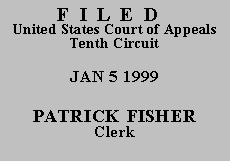

| UNITED STATES OF AMERICA, | No. 97-5220
(D.C. No. 96-CR-151-H) |
Upon pleading guilty to several charges stemming from his role in a drug distribution conspiracy, appellant Glenn was sentenced to life imprisonment. Relying on the testimony of a witness who testified at the drug conspiracy trial of appellant's co-defendants, the sentencing court found that appellant possessed a dangerous weapon while engaging in a drug trafficking offense, thus warranting a two-level enhancement pursuant to U.S.S.G. § 2D1.1(b)(1). The district court also found that by fleeing arrest, appellant willfully sought to obstruct justice so as to justify a two-level enhancement under U.S.S.G. § 3C1.1. At sentencing, appellant objected to both enhancements.
We review a sentencing court's factual findings for clear error. Its legal interpretation of the Sentencing Guidelines, we subject to de novo review. See United States v. Wilson, 41 F.3d 1403, 1404 (10th Cir. 1994).
Asserting a Sixth Amendment confrontation claim, appellant argues that in enhancing his sentence under § 2D1.1(b)(1), the district court erroneously relied on the testimony of a witness he was unable to cross-examine. We have held, however, that at sentencing "a defendant does not have an absolute right to confront witnesses whose information is made available to the court." United States v. Beaulieau, 893 F.2d 1177, 1180 (10th Cir. 1990); accord United States v. Wise, 976 F.2d 393, 398 (8th Cir. 1992); United States v. Carmona, 873 F.2d 569, 574 (2d Cir. 1989). Rather, testimony from a separate trial, if reliable, is admissible at sentencing. See Beaulieu, 893 F.2d at 1181. We discern no Sixth Amendment violation here because appellant's guilty plea lends sufficient reliability to the testimony of the witness in question. At the trial of appellant's co-conspirators, the witness testified that appellant possessed weapons during the commission of a drug trafficking offense. In statements of fact accompanying his guilty plea, appellant himself admitted to possessing weapons found in a mobile home that he used to distribute methamphetamine.
Appellant argues, however, that even with the witness's testimony and his own admission, the prosecution failed to carry its burden of proving that he possessed the weapons in question during the commission of a drug trafficking offense. We agree that the government has a burden of proving by a "preponderance of the evidence" that the defendant possessed a dangerous weapon. United States v. Jackson, 11 F.3d 953, 956 (10th Cir. 1993). However, we have also said the government meets this burden if, given the totality of the circumstances, it is not "clearly improbable" that the weapon was connected to the offense. United States v. Nguyen, 1 F.3d 972, 973 (10th Cir. 1993).
In this case the police found several weapons in close proximity to a quantity of drugs discovered at appellant's home. Appellant also pled guilty to possession of the weapons. As we review a sentencing court's factual findings for clear error, we conclude the court correctly found that appellant possessed dangerous weapons during the commission of a drug trafficking offense. We affirm the court's enhancement of his sentence under U.S.S.G. § 2D1.1(b)(1).
Appellant next argues that the court erred when it enhanced his sentence by two levels for obstruction of justice pursuant to U.S.S.G. § 3C1.1. We review for clear error a district court's factual findings concerning enhancement for obstruction of justice under U.S.S.G. § 3C1.1. See United States v. Hankins, 127 F.3d 932, 934 (10th Cir. 1997).
A sentencing court may impose a two-level increase in the offense level "if the defendant willfully obstructed or impeded, or attempted to obstruct or impede, the administration of justice during the investigation, prosecution, or sentencing of the instant offense." U.S.S.G. § 3C1.1. For purposes of this adjustment, obstruction of justice includes "escaping or attempting to escape from custody before trial or sentencing." See U.S.S.G. § 3C1.1, comment. (n.4(e)).
Appellant challenges the applicability of § 3C1.1, contending his flight was instinctive and not "calculated to mislead or deceive authorities." Appellant's Br. at 16-17. This argument finds no support in the record. Following his arrest, appellant was released on a state bond. As part of an organized effort, he then joined several others in fleeing from authorities. This was not an instinctive flight that occurs immediately upon being confronted with law enforcement authorities.
We must also reject appellant's argument that § 3C1.1 does not apply here because at the time of his flight, no indictment had been filed nor was he under subpoena. The Guidelines acknowledge that, standing alone, certain conduct, like appellant's flight in this case, may not warrant enhancement under § 3C1.1. "However, if the defendant is convicted of a separate count for such conduct," the sentencing court is authorized to apply § 3C1.1, and enhance the offense level. U.S.S.G. § 3C1.1, comment. (n.5).
In this case, appellant was convicted on a separate count of conspiracy to flee to avoid prosecution. The sentencing court therefore appropriately enhanced his offense by two levels under U.S.S.G. § 3C1.1.
AFFIRMED.
ENTERED FOR THE COURT
Carlos F. Lucero
Circuit Judge
*. This order and judgment is not binding precedent, except under the doctrines of law of the case, res judicata, and collateral estoppel. This court generally disfavors the citation of orders and judgments; nevertheless, an order and judgment may be cited under the terms and conditions of 10th Cir. R. 36.3.